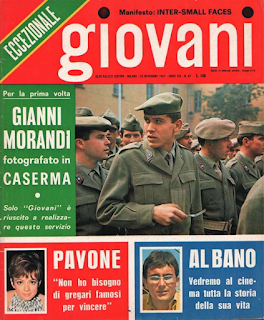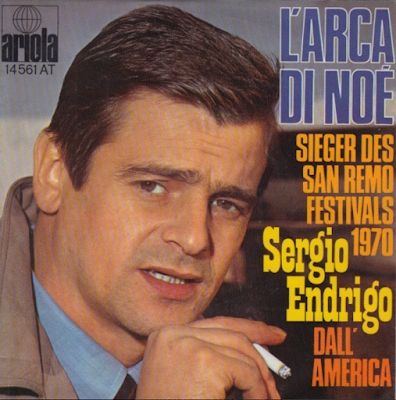Sunday, November 13, 2016
Thursday, June 9, 2016
18 Aprile 1964 Italian hit parade
Here's an example of Italian singles' charts: 18 April 1964 - and its correlation to Brazilian charts of 7 months later. In other words... it took approximately between 6 months to one year for an Italian single to reach the Brazilian charts whenever it did.
Let's only take the singles that entered both Italian and Brazilian charts: John Foster's 'Amore scusami' reached #1 in Italy on 18 April 1964; after exactly 9 months 'Amore scusami' reached #1 in Brazil 9 on 5 January 1965.
Adriano Celentano never charted in Brazil for some mysterious reason. But take Mina's 'È l'uomo per me' (He walks like a man) which fell from the #1 position in Italy this week; 5 months later (September 1964), Mina took 'È l'uomo per me' to #8 in the Brazilian charts. Incidentally, this was the only hit Mina produced in Brazil. As with Adriano Celentano, Mina was a non-entity in Brazil.
Richard Anthony's 'Cin cin' was #1 in Italy in March 1964; 7 months later - October 1964 - it also reached #1 in Brazil.
Gianni Morandi's 'In ginocchio da te' reached #1 in Italy circa June; five months later - November 1964 - 'In ginocchio da te' reached # 5 in Brazil.
Nico Fidenco's 'Con te sulla spiaggia' went up the Italian charts in April 1964; 6 months later - November 1964 - 'Con te sulla spiaggia' reached #15 in Brazil .
Rita Pavone's 'Scrivi' went up 13 notches to #12 in April 1964 in Italy; in Brazil, Pavone took 'Scrivi' up to #1 - 3 months later (August 1964). The reason why it went all the way up to #1 was due to Rita Pavone's popular tour of Brazil in late June 1964. She had introduced 'Scrivi' 'live' on TV and as 'Datemi un martello' was slacking in sales, 'Scrivi' picked it up with a vengeance.
Bobby Solo's 'Credi a me' reached #13 in Italy in April. It played well on Brazilian radio waves but as 'Una lacrima sul viso' was still being played nationally - it stayed at #2 for 8 weeks circa June-July 1964 'Credi a me' hadn't much of a chance.
So from out of a list of the 30 best selling singles in Italy in April 1964 - Brazilians bought 8 singles which made a little less than one-third which is still impressive when one could hardly see any Italian hits on Brazilian charts just one year ago.
Saturday, May 28, 2016
youth magazines imported from Italy in the 1960s.
The so-called Italian music invasion of Brazil started up in mid to late 1963. with Nico Fidenco's 'Legata a un granello di sabbia' and Emilio Pericoli's 'Al di là'.
In 1964, Rita Pavone's 'Datemi un martello' was the best selling single in the country; the runner-up was Sergio Endrigo's 'Io che amo solo te'...
1965 started with John Foster's 'Amore scusami' at the top of the charts; in March 1965, Bobby Solo's 'Se piangi se ridi' was #1... and by August 1965, Pino Donaggio's 'Io che non vivo (senza te)' was #1 in the whole country.
Then, as of September 1965, Brazilian rock aka Jovem Guarda (Young Guard) took over from the Italians... but one could still listen to Italian hits like Gianni Morandi's 'In ginocchio da te' on the radio.
As 1966 started, suddenly, out of the blue there was a 'flood' of Italian magazines on the newsstands of Sao Paulo & Rio de Janeiro. Italian illustrated magazines like 'Oggi', 'Gente', 'L' Europeo' etc. were common but not youth-oriented-magazines... that was new! 'BIG' was the first Italian youth-magazine I bought. 'Giovani' came out soon after...
In Rio de Janeiro, for being a sea-port city one could find a much wider variety of Italian rags like 'Bolero', 'Sorrisi e Canzoni' and others. Here are some examples of the Italian youth-magazines I used to cherish.
In 1964, Rita Pavone's 'Datemi un martello' was the best selling single in the country; the runner-up was Sergio Endrigo's 'Io che amo solo te'...
1965 started with John Foster's 'Amore scusami' at the top of the charts; in March 1965, Bobby Solo's 'Se piangi se ridi' was #1... and by August 1965, Pino Donaggio's 'Io che non vivo (senza te)' was #1 in the whole country.
Then, as of September 1965, Brazilian rock aka Jovem Guarda (Young Guard) took over from the Italians... but one could still listen to Italian hits like Gianni Morandi's 'In ginocchio da te' on the radio.
As 1966 started, suddenly, out of the blue there was a 'flood' of Italian magazines on the newsstands of Sao Paulo & Rio de Janeiro. Italian illustrated magazines like 'Oggi', 'Gente', 'L' Europeo' etc. were common but not youth-oriented-magazines... that was new! 'BIG' was the first Italian youth-magazine I bought. 'Giovani' came out soon after...
In Rio de Janeiro, for being a sea-port city one could find a much wider variety of Italian rags like 'Bolero', 'Sorrisi e Canzoni' and others. Here are some examples of the Italian youth-magazines I used to cherish.
'Big', 10 September 1965.
21 Gennaio 1966 (Edoardo Vianello); 4 Febbraio 1966 (Rita Pavone);
'Big' 4 Marzo 1966 (Cantagiro): Big, 1st June 1966 (Rita Pavone).
2 Luglio 1966 with Michele; 20 August 1966 with Dino.
12 March 1966; 29 October 1966.
9 Marzo 1967; Cantagiro 1967.
Francesi on 26 Gennaio 1967; Mick Jagger in April 1967.
Rita's 4th movie 'La feldmarescialla' 1967:Morandi at the Italian Army, 25 November 1967.
Sergio Endrigo's E.P.s for Cetra-Fermata and RCA
Sergio Endrigo EPE-601 issued by Fermata-Cetra in 1967 featuring 'Mani bucate' (1965).
Fermata relesead this EPE-553 in early 1966, featuring 'Una casa in cima al mondo' (Claudio Villa); 'Adesso si' (Sergio Endrigo); 'Nessuno di voi' (Milva) and 'Io non posso crederti' (Franco Tozzi). All four songs (plus 8 additional others) had been released 'live' from the San Remo Auditorium in an album produced by Brazilian DJ Miguel Vaccaro Netto. Here in this E.P. all songs were studio recorded.
Endrigo finally wins San Remo in 1968, with 'Canzone per te' EPE-594. 'Teresa' and 'Adesso si' from San Remo 1966 complete the selection.
Even though 'Lontano dagli occhi' was introduced by Sergio Endrigo and Welsh singer Mary Hopkin at San Remo 1967, this 'Sophia' EPE-613 was realeased in late 1968, well after 'Canzone per te'.
'Era d'estate'-'Ora che sai'; Endrigo's 2nd E.P. for RCA in 1965, released after the phenomenal successful 'Annamaria' (1964).
'Annamaria' in 1964 is probably the best selling EP ever to chart the Brazilian Hit Parade. It simply contained 4 of Endrigo's best songs; 'Annamaria', 'Io che amo solo te', 'Aria di neve' and 'Basta così'.
Subscribe to:
Posts (Atom)












.jpg)



































